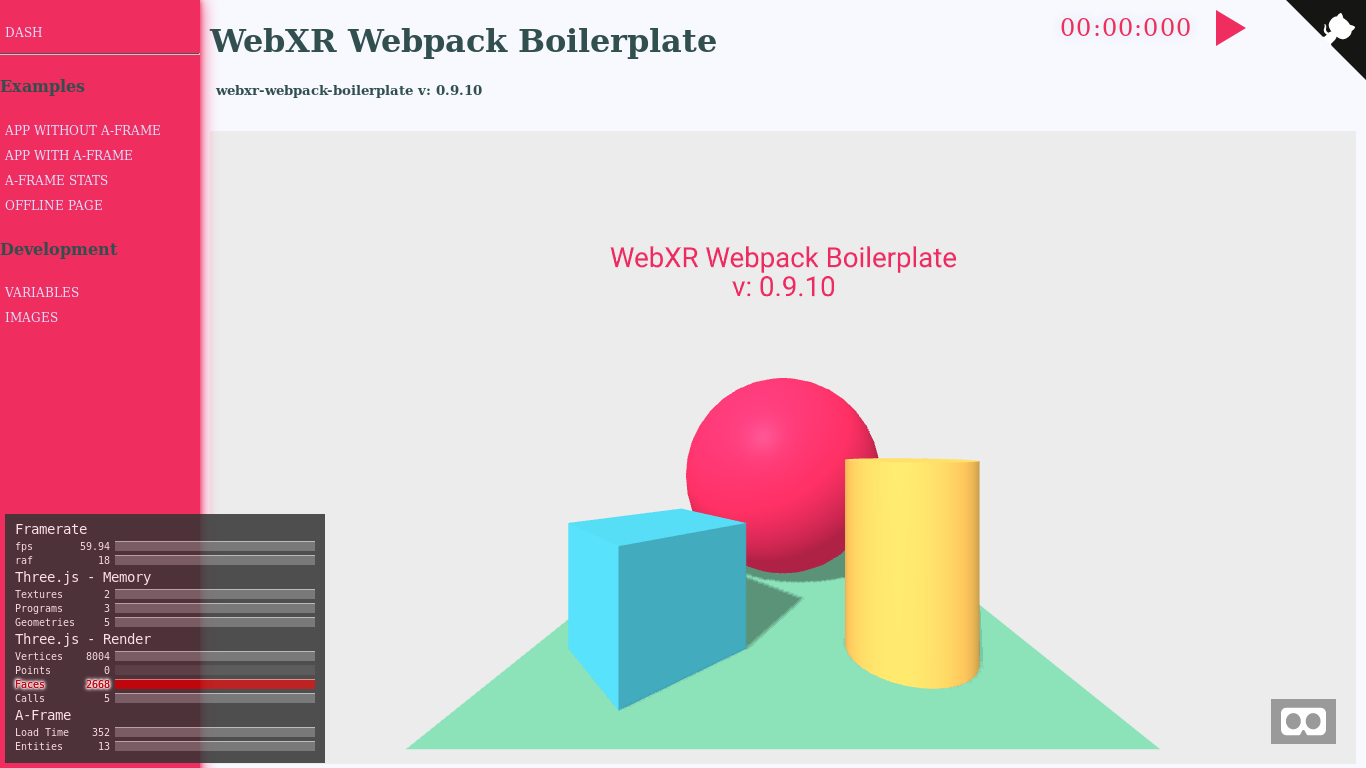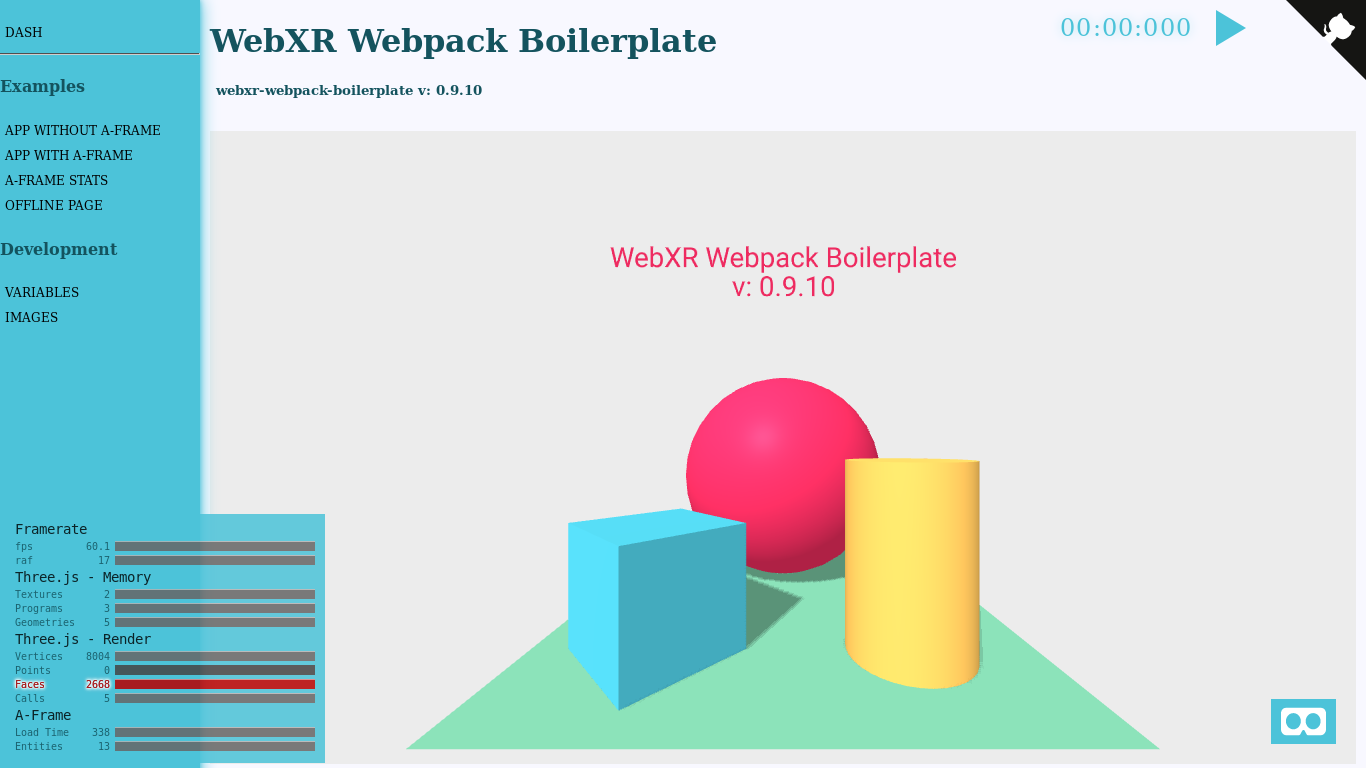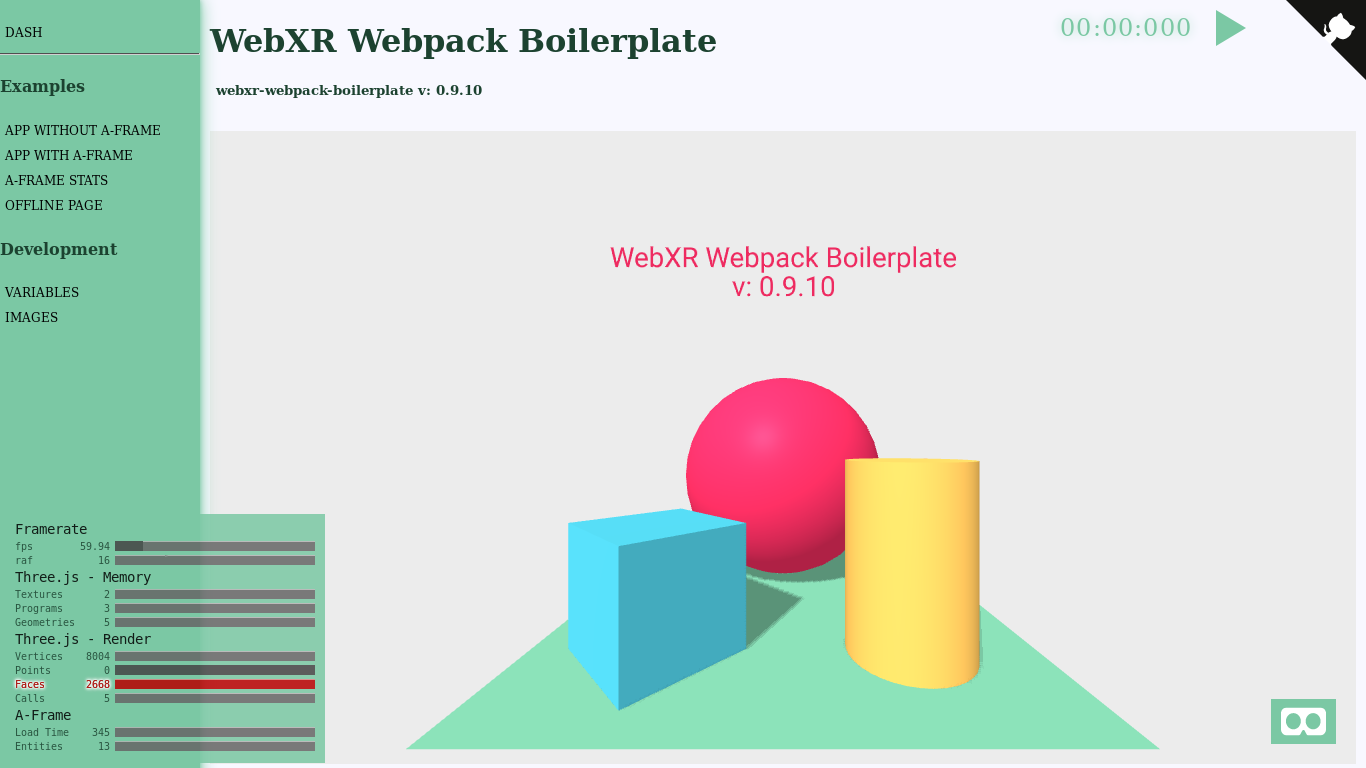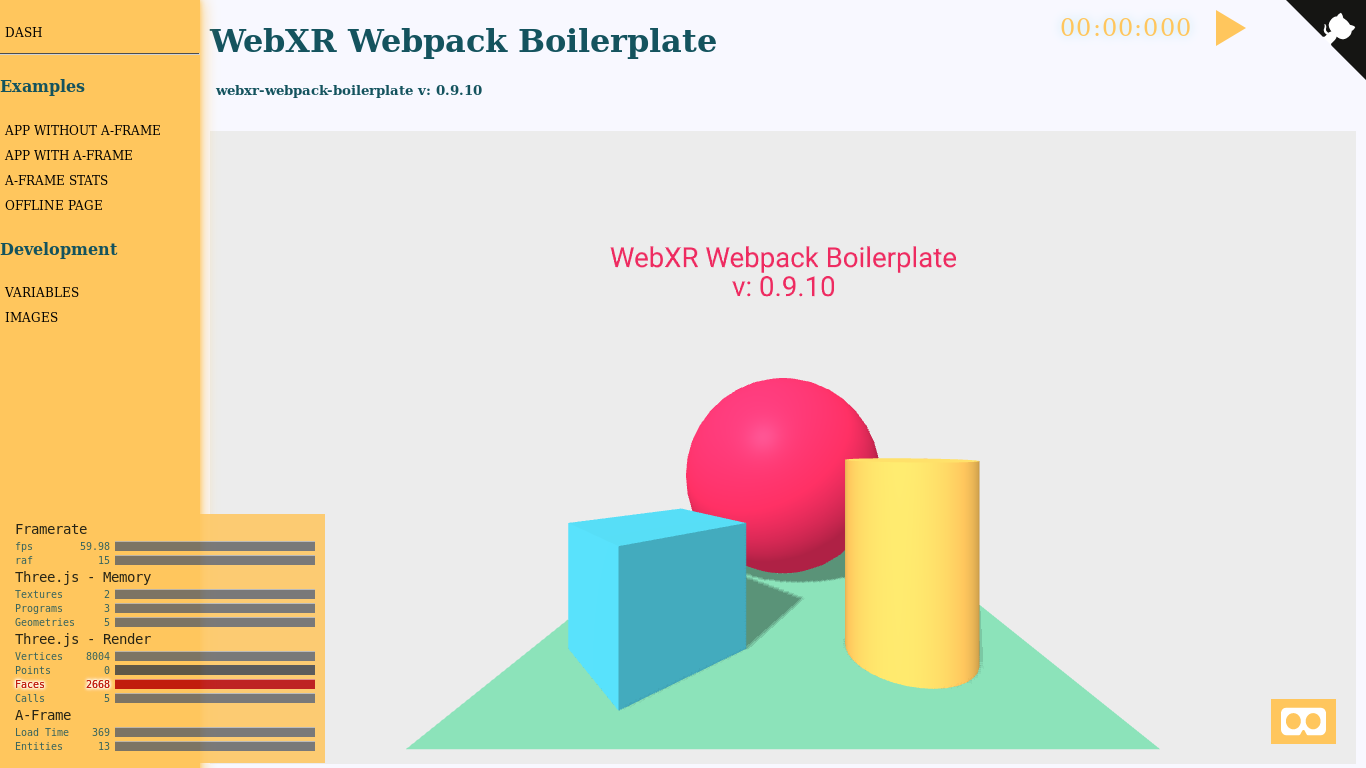mkungla / Webxr Webpack Boilerplate
Programming Languages
Projects that are alternatives of or similar to Webxr Webpack Boilerplate
WebXR Webpack Boilerplate
Starter Kit for building rich, immersive WebXR projects (featuring A-Frame) PWA with Webpack, Handlebars and SASS
Introduction
The goal of WebXR Webpack Boilerplate is to provide a high-quality, high-performance code base to accelerate WebXR development and specially prototyping. It is designed to be flexible in order to support rapid implementation and customization within your project. — take a look at demo
Personally I use this boilerplate mostly for quick prototyping WebXR ideas,
while final product going to production may require major refactoring the code base.
@mkungla
Project build status
| Linux | macOS | Windows |
|---|---|---|
- Overview
- Getting Started
- Development
- Build and deploy
Overview
Here is overview of WebXR Webpack Boilerplate project and what's included.
Custom A-Frame Theme
| red | blue | green | yellow |
|---|---|---|---|
 |
 |
 |
 |
You can change A-Frame themes by modifying ./app.json sassTheme property which sets SASS configuration $theme variable
// Color themes red !default, yellow, green, blue
{
"sassTheme": "red"
}
if that property is not set then default theme is used in src/style/_theme-vars.scss
// Color themes red !default, yellow, green, blue
$theme: red !default;
Project structure
Project ./src contains some unnecessary files which are included for demo and example purposes. You can remove all of these files and associated references and imports from your project.
- .circleci CircleCI Continuous Integration and Delivery configurations, feel free to delete that if you dont use CircleCI as your CI provider. This project uses CircleCI for macOS builds.
- .github All Github related config files.
-
build Build directory
yarn run build. - devel Development related files like webpack and project configuration files.
-
src Project source files.
-
hbs Project handlebars templates
-
index.hbs outputs
./build/index.html -
partials handlebars partials used within views
- aframe partials for A-Frame entities
- app app partials
- html common html partials like headrs and footers
- scenes good place to put markup of your different WebXR scenes.
-
index.hbs outputs
-
js Application javascript code and entry points
- aframe A-Frame compnents,systems.shaders. Create your custom A-Frame components to this directory.
- lib-aframe.js In this file you would import A-Frame, external npm components and also your custom components which will be bundled into one single file ensuring that your component registration is done right.
- app.js Main app entrypoint. File where you configure the application, while you should avoid writing your application logic code there. Instead use ./src/js/application/addons for that. Take look at Minimal example of app.js
-
application Application javascript code
- addons Most of your application logic should be here in application addons. Take a look at Example Addon
- core Application core most of cases you don't need to edit this code however if you find something add or enhance there please consider opening a pull request and contribute your modification to this project.
- background.worker.js Background web Worker if you need to use one, which requires you do modifications in ./src/js/application/core/index.js how your worker is behaving and change webpack config in ./devel/webpack/configure-app.js to load and build that Worker correctly.
-
vendors.js In this file you would import all your external vendor dependencies
e.g. Lodash, jQuery etc.If any of vendor libraries have embedded styles then these will be extracted to./buid/app/css/vendors.cssso make sure that you import it in your handlebars header template usede.g../src/hbs/partials/html/header.hbs If you need to customize some vendor styles then use ./src/style/vendors/vendors-style.scss for that.
-
pwa Progressive Web App entrypoint, service worker and other PWA assets. Everything in this directory could be taken as independent app from main app and since the handlebars templates result html pages in
./buildroot then you should make sure that you dont have conflicting file names which would result only one of them being created. If you want to change that behavior edit ./devel/webpack/configure-pwa.js config. Also note that even though you can cross reference handlebar templates within webpack cross compiler you should try to avoid that and keep your partials related to views found in./src/pwain./src/pwa/pwa-partials-
logo.png Changing that logo will generate all the variations of your logo under
./build/assets/pwa/using webapp-webpack-plugin - offline.js entrypoint you could use for app when application is offline.
- offline.scss example offline style entry
-
pwa-partials handlebars partials related to views found in
./src/pwa
-
logo.png Changing that logo will generate all the variations of your logo under
-
static Static assets copied over to
./build/assets/static. By default onlyCopyWebpackPluginis used if you need more control edit ./devel/webpack/configure-static-assets.js config file.- audio
- images
- models
- video
-
style Application style scss files
- app.scss main app entrypoint
-
theme directory to contain your theme sass partials
- _theme-base.scss theme base file, if that file grows to big separate your design into smaller partials under same directory and include these in ./src/style/app.scss
- _theme-vars.scss scss file where you define your theme variables
-
vendors Vendor styles
- vendors-style.scss vendor style entrypoint
-
- tests tests.
- tmp temporary and local files which are not tracked by git.
Getting Started
instructions to set up your project
Setup project based on this repository
Follow one of the 3 options below which suits best for your needs. Options below are shown for github.com public and private repositories, so if your project will be hosted elsewhere you know your self what you have to change.
Create fork to contribute back to this repository
(option 1)
First Fork this repository in github.com
Next navigate to directory where you keep your projects and set following temporary environment variables
cd <your-projects>
GITHUB_USERNAME="<github-username>"
Next clone full copy of this repository and set remotes to be able to sync your repository with upstream
git clone --origin github/"$GITHUB_USERNAME" [email protected]:$GITHUB_USERNAME/webxr-webpack-boilerplate.git
cd webxr-webpack-boilerplate
git remote add github/digaverse [email protected]:digaverse/webxr-webpack-boilerplate.git
and start hacking.
Create new project based on this repository and keep commit history
(option 2)
First navigate to directory you keep your projects and set following temporary environment variables
cd <your-projects>
GITHUB_USERNAME="<github-username>"
# PROJECT_NAME should be valid github repository name
PROJECT_NAME="<your-new-project-name>"
Next go and create new public or private repository under $GITHUB_USERNAME and set project name same as $PROJECT_NAME. While creating the repository make sure that no default files are created,
- unselect
Initialize this repository with a README - make sure that both
Add .gitignore and Add a licenseare set to NONE
Next
git clone --bare [email protected]:digaverse/webxr-webpack-boilerplate.git
cd webxr-webpack-boilerplate.git
git push --mirror [email protected]:$GITHUB_USERNAME/$PROJECT_NAME.git
cd ..
rm -rf webxr-webpack-boilerplate.git
git clone --origin github/"$GITHUB_USERNAME" [email protected]:$GITHUB_USERNAME/$PROJECT_NAME.git
and start hacking.
Create new project based on this repository without commit history
(option 3)
First navigate to directory you keep your projects and set following temporary environment variables
cd <your-projects>
GITHUB_USERNAME="<github-username>"
# PROJECT_NAME should be valid github repository name
PROJECT_NAME="<your-new-project-name>"
Next go and create new public or private repository under $GITHUB_USERNAME and set project name same as $PROJECT_NAME. While creating the repository make sure that no default files are created,
- unselect
Initialize this repository with a README - make sure that both
Add .gitignore and Add a licenseare set to NONE
git clone --depth=1 [email protected]:digaverse/webxr-webpack-boilerplate.git $PROJECT_NAME
cd "$PROJECT_NAME"
rm -rf .git
git init
git add -A && git commit -m"initial commit"
git remote add github/"$GITHUB_USERNAME" [email protected]:$GITHUB_USERNAME/$PROJECT_NAME.git
git push -u github/"$GITHUB_USERNAME" master
and start hacking.
Build and development server configuration
Most of build and configuration options can be set in ./app-dev.json, but if you need more control or customization look into config files in ./devel directory.
First run
make sure you have yarn installed, alternately you can use npm command instead yarn
# copy app-dev.json
cp example.app-dev.json app-dev.json
# copy app.json
cp example.app.json app.json
# install and setup
yarn install
yarn run setup # first time run generates SSL certificates so we can serve https and http2 locally
yarn build # creates static assets under ./build directory
to start the dev server run
yarn start
You may need to update/rebuild static assets sometimes then just run yarn run build before yarn start.
And now open your browser https://localhost:9000 and accept self signed certificates.
Development
application configuration file is ./app.json all properties will be available within both in handlebars templates and PROJECT.{property} and in application/addon level this.session.get('config').{property} while most of webpack config is set in ./app-dev.json. Keep in mind when you edit these files you have to restart development server in order these changes to take effect.
Minimal example of app js
Here is minimal Example for ./src/js/app.js
/* global PROJECT */
import Application from './application/core'
// import application addons you want to register
// import yourAddon from './application/addons/your-addon'
const app = new Application(PROJECT)
// Reqister all application addons by calling registerAddon
// app.registerAddon(yourAddon, addonConfigObject)
// Start the application as soon as possible
app.start().then((log) => {
log.debug('webapp is running callback')
}).catch((err) => {
console.error(err)
})
Project is shipped with example adding controls to start/stop/play/pause application.
NOTE that application start/stop/play/pause does not affect A-Frame scene. If you wich to do so then you have to set {"ppaframe": true} in ./app.json. Also when you have page which does not have A-Frame scene but in header template you load lib-aframe.js then application will not play since A-Frame core system is paused when <a-scene> is not found, so you may better create different header file wich you include in pages which do not have a A-Frame scene so that application falls back to using window.requestAnimationFrame.
Example Addon
Most of application logic is added to application by creating and registering Addons. bellow is outline of how to define your Addon.
/* ./application/addons/your-addon */
export default {
name: 'your-addon',
// this addon will not be reqistered if aframe is not present on loaded page
// default false
aframeRequired: true,
// You can set configuration defaults to your Addon here
// or set that object as second parameter when you register
// your Addon by calling app.registerAddon()
data: {},
setup() {
// Called once when you register the Addon
// Sets the data to values passed to registerAddon 2 param
// Within addon following properties are set
//
// this.aframeRequired - is aframe required
// this.enabled - is addon enabled
// this.isPlaying - is addon playing
// this.name - addon given name
// this.data - addon configuration
// this.app - reference to app
// this.app.session - access application session
// this.app.store - app localStorage
// this.app.addons['addon-name'] - access other registered addons
// ``
// this.log - gives named logger for current addon.
// Displaying these messages depends on
// your ./app.json setting which logLevel is set
// this.log.debug(args...)
// this.log.info(args...)
// this.log.ok(args...)
// this.log.warn(args...)
// this.log.error(args...)
},
start() {
// Called every time when you start the application
// and everytime when you call application start after stoping it.
},
play() {
// Called every time when application play is called
},
pause() {
// Called every time when application pause is called
},
tick() {
// Called in every render loop when application is playing
},
dispose() {
// Called when application stop is called.
// Currently dispose does not delete this Addon
// so calling application start after stop will call
// this objects .start again, but not .setup .
// This behavior may change in this project skeleton
// in the future allowing you to dispose Addons on
// run time and re register Addons on demand.
// Therefore the name dispose instead of stop
// which it is right now by behavior.
}
}
Add A-Frame components
yarn add <some-aframe-component>
add import statement to ./src/js/lib-aframe.js
Add 3rd party libraries
yarn add <some-library>
if needed add import statement to ./src/js/vendors.js if you want to bundle that dependency together with other 3rd party libraries or sass import statment to ./src/style/vendors/vendors-style.scss when adding 3rd party styles.
Build and deploy
Static app
To build static site just run
# (not required): do sign version git tags
yarn config set version-sign-git-tag true
# (not required): to remove "v" version-tag-prefix
yarn config set version-tag-prefix ""
# (not required): do update version
yarn version
# build everything into ./build directory
yarn build
# git push to remote
git push && git push --tags
Contents of ./build directory are ready to be served just copy contents of ./build directory to your webserver root. e.g. demo is hosted with github pages, take a look at gh-pages branch for example
Build and run Docker image
requires yarn build before
yarn run build:docker
and fire up your docker image
yarn run start:docker
And now open your browser https://localhost:8080



